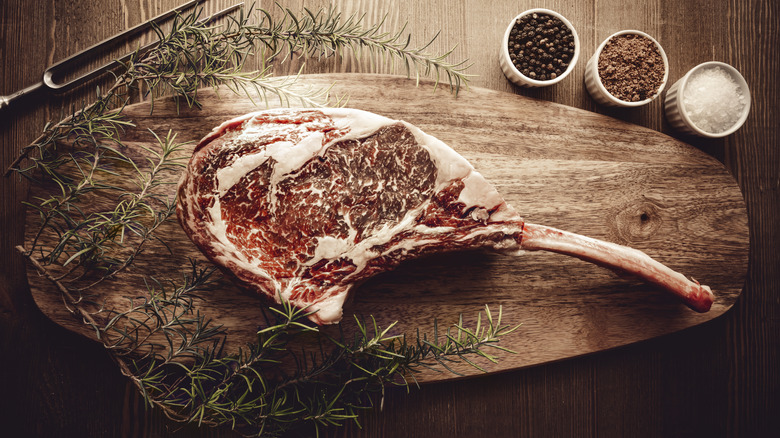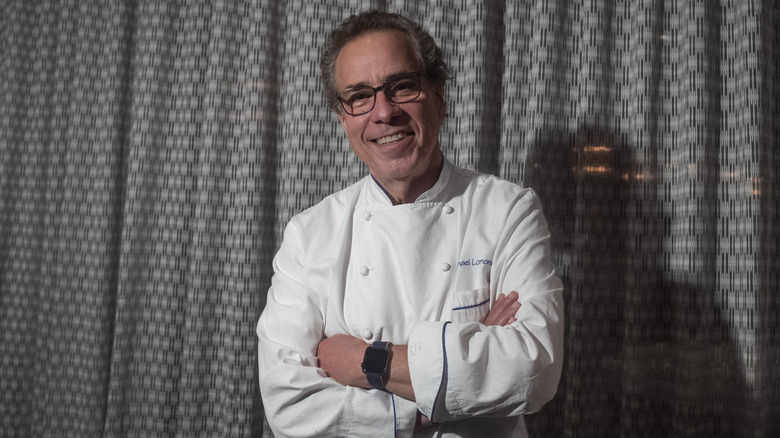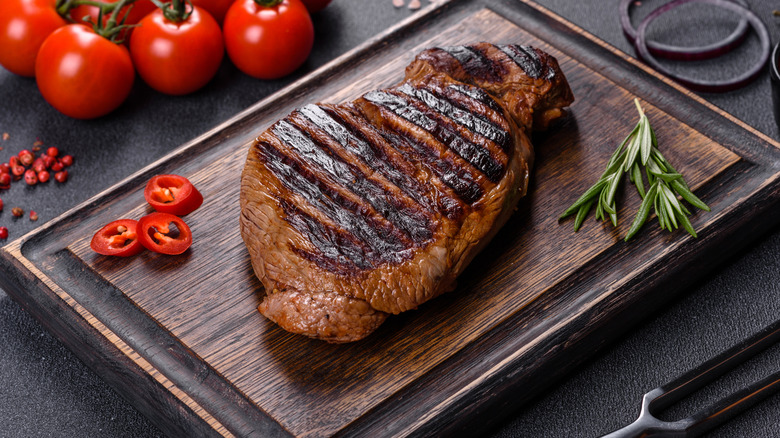The Reason Dry Aged Beef Is A Particularly Tricky Cut For Grilling
A perfectly-grilled steak is widely regarded as the most luxurious of meals, and a dry-aged steak is widely seen as the most luxurious of steaks. The process of dry-aging beef entails leaving the meat in a humidity-controlled environment for about a month or so. During that time, water gets drawn out of the muscle to the surface of the meat, where it then evaporates.
Most meats are composed of around 75% water, but the dry aging process decreases the water-to-muscle ratio, making the flavor of the beef more concentrated. The chemical compounds within the meat also change during this time to create a uniquely funky umami flavor that is highly prized by beef connoisseurs. This moisture loss can, however, pose a challenge, particularly for beginning grillmeisters. To get an insider's perspective on the tricky art of grilling dry-aged beef, Chowhound spoke to chef Michael Lomonaco of the legendary New York steakhouse, Porter House Bar and Grill.
Michael Lomonaco's warning about dry-aged beef
Chef Lomonaco knows a thing or two about steak, particularly dry aged cuts. Porter House's signature dish and namesake, their USDA Prime porterhouse steak, is dry aged for 28 days before grilling. But while dry aged beef is a centerpiece in Lomonaco's culinary repertoire, he singles it out as one of the most difficult types of steaks to grill.
"The dry aging process has eliminated a good deal of [the cut's] natural moisture. This makes grilling dry aged beefsteaks particularly tricky since the aged beef doesn't have the same 'give' when pressed using the push test," he told us.
This might not be too much of a problem because the touch test for determining meat doneness has actually proven to be fairly unreliable in studies, but it's different for the pros than it is for beginners. The more steaks you cook, the better attuned to texture you'll become, and with practice, you can learn to gauge doneness based on the meat's texture. The issue with dry-aged steaks is that minus all that moisture, their texture isn't the same as a regular steak, so you have to relearn the rules a bit.
Beginning grillers should pick a different cut
Dry-aged steaks are among the most highly prized, but unsurprisingly, the extra time and effort they require drives the price up. If you're just beginning to perfect your grilling skills, diving right into the dry-aged world can really burn a hole in your wallet if you don't get things just right. That's why Chef Lomonaco recommends more affordable steak cuts that allow more room for error.
"I recommend your steak journey begin with more forgiving and affordable cuts like London Broil and Chuck steaks before moving into the area of the higher cost rib steaks and strip steaks," Lomonaco told us. "As your grilling prowess develops, these are the steaks you will desire more, and giving yourself the opportunity to learn the ins and outs of the particular grill you use will make it all seem like you're the master of your domain."


